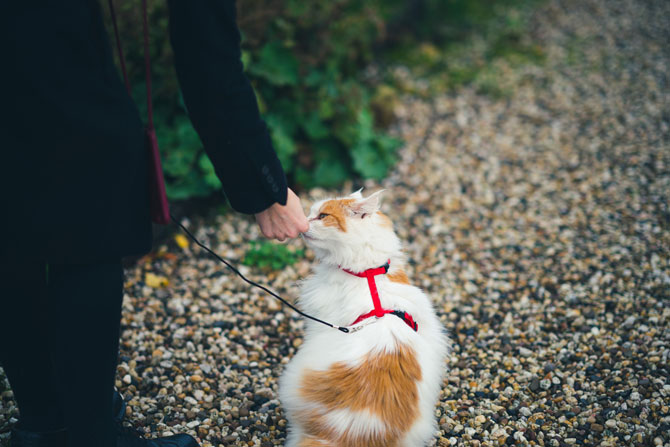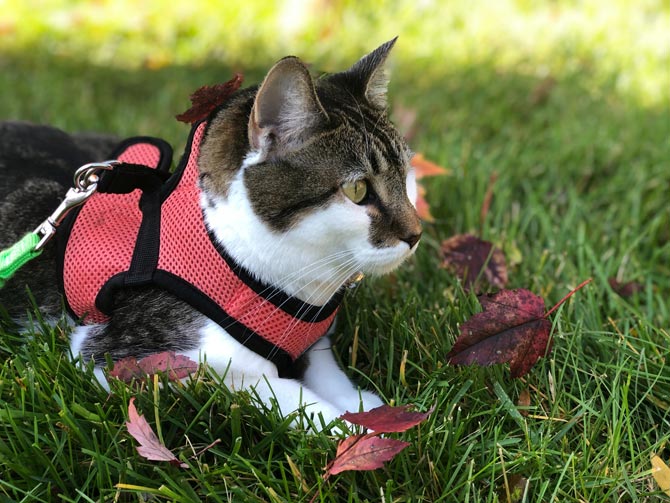Aussie cat owners are encouraged to keep their feline friends indoors from dusk to dawn. This is to protect Australia’s native wildlife, as well as to safeguard our meowing mates from road hazards.
In fact, in some states, the local councils are introducing cat curfews, which specify all domestic cats should be kept indoors, or in an outdoor shelter, between 8pm and 7am.
With the potential for more states and councils to introduce cat curfews, many owners are looking to leash train their cats.
Pros and cons of walking your cat on a leash
Of course, I’m sure some cat lovers are saying, ‘but it’s so cruel to walk your cat on a leash’. But then there’s the argument it’s cruel to keep your cat cooped up indoors. So, what’s a cat parent to do for the best?
Here are some of the positives and negatives of putting your cat on a leash.
PROS
It can be dangerous for cats (and local wildlife) to wander around outdoors. Putting your cat on a leash allows them to exercise safely.
Some people like to take their feline friend on holiday with them. Training their cat to walk on a leash may help prevent their cat from getting lost in an unfamiliar place.
Being able to put your cat on a leash and walk around an area you’ve recently moved to can be helpful. It can assist your meowing mate to get to know its new environment.
Some cats, especially cats that are very anxious or nervous, may enjoy walking on a leash. They may like having their owner by the side.
Some cats may be unable to be left outdoors alone due to a health problem. Being able to walk the cat on a leash could provide much-needed mental stimulation for the kitty.
Being on a leash may not be as fun for a cat who’s used to free-roaming, but at least it gives it exercise and allows it to burn off pent-up energy.
CONS
Leash walking is unfamiliar to cats. As such, it might cause our furry friends undue stress.
Cats, particularly mischievous ones, may be able to slip free from their collar or jump away from their owner. This could potentially cause the cat to become injured.
Walking your cat on a leash may expose them to strange sights and sounds. Imagine if a dog starts barking at them or a car horn sounds nearby? This can be overwhelming and frightening—especially if your cat is used to the peace and quiet of indoors.
Any pet owner who intends to put their cat on a leash and take it outdoors must make certain their kitty is up to date with its vaccinations. Plus, it’s worthwhile getting the cat microchipped too—just in case it does a Houdini and escapes!
Cats can be fussy; some cats simply won’t take to walking on a leash. This situation can be quite stressful for owners. So, before you rush out to buy a leash, make sure leash training is right for your purring pal.
Cats don’t walk on a leash in the same way dogs do. Cats tend to stop often to sniff, see what’s going on around them and assess the situation. This can be quite annoying for pet owners—particularly if your aim was to pound the pavement at high speed by way of exercise.

Photo by Ayelt van Veen on Unsplash
Things to consider before putting your cat on a leash
Still keen to try putting your purring pal on a leash? Assuming you’ve weighed up the pros and cons and you feel leash walking is right for your cat, here at a few extra considerations.
NOTE: In general, the RSPCA does not recommend leash training for cats. However, its policy is that if owners decide to walk their cat it should be done under direct supervision using a leash and harness, rather than a collar.
All cats are different
Some cats will no doubt enjoy walking on a leash. Others may loathe the leash. It’s important to be mindful of your cat’s personality and how they react to the leash.
Not every cat will take to leash training so don’t force your cat; your cat’s wellbeing should come first.
The right harness
As mentioned, the RSPCA supports using a harness rather than a collar. It’s more difficult for your meowing mate to wriggle its way out of a harness.
Don’t be tempted to use a small dog harness, as these can be designed differently from a dedicated cat harness. Make sure it fits well and is made of lightweight, comfortable material.
Slowly does it
You can’t just pop your cat on a leash and expect it to go for a walk. Sure, this would make things a lot easier but it’s probably not going to be that simple.
You need to take your time. Let your cat get used to wearing the harness (without the leash attached) in the comfort of home. Move up a level by attaching the leash and encouraging him to walk around your house or garden with you. Eventually, you can work towards taking your cat outdoors on the leash.
NOTE: If your cat displays signs of anxiety or fear, don’t push it. Go back a step until your cat feels comfortable again.
If your feline friend learns to love being outdoors on a leash, that’s fantastic. On the other hand, if you discover your purring pal would rather be indoors without the harness, that’s okay too.
After all, the aim of teaching your cat to walk on a leash is to enrich your cat’s life.
What’s your experience of teaching a cat to walk on a leash?
Main image source: Photo by Greeshma Gangadharan on Unsplash







Leave A Comment